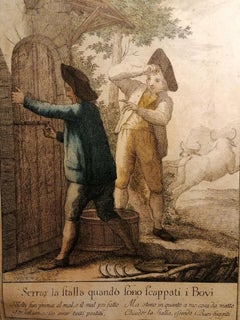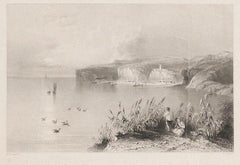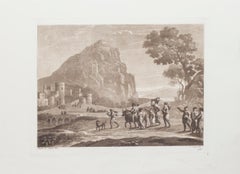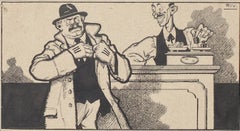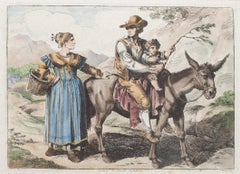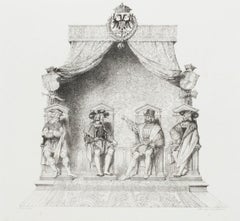Early 19th Century Art
to
737
1,521
282
196
70
58
Overall Width
to
Overall Height
to
7,501
20,722
155,850
236,876
1,877
2,279
4,824
6,387
5,904
13,138
20,073
24,817
17,381
13,284
5,308
565
295
58
4
3
2
2
1
1
1
1,071
1,005
17
1,537
729
541
469
363
346
314
173
162
154
139
74
71
70
66
66
62
53
46
46
920
697
387
301
285
311
48
26
24
20
561
865
974
471
Period: Early 19th Century
Lock the Barn when the Oxen have Fled - Original Etching - Early 19th Century
Located in Roma, IT
Lock the Barn when the Oxen have fled is an original modern artwork realized in the first decades of the 19th Century.
Original colored Etching on paper.
A long inscription is pres...
Category
Modern Early 19th Century Art
Materials
Etching
Nicopolis - Original Lithograph by W.H. Bartlett - Early 19th Century
By W. H. Bartlett
Located in Roma, IT
Nicopolis is an original lithography artwork on paper realized by W.H. Bartlett (1809-1854).
Signed on the plate on the lower left.Titled on the lower center.
Included a passeparto...
Category
Early 19th Century Art
Materials
Lithograph
Landscape - Etching and Aquatint on Paper by L. Caracciolo After C. Lorrain
Located in Roma, IT
Landscape is an original etching and aquatint on paper realized by Claudio di Lorena.
Signed on the plate, on the lower left. plate no. 183, lower on the right, edition "L. Caraccio...
Category
Early 19th Century Art
Materials
Etching, Aquatint
Pharmacist - Original China Ink on Paper by Carlo Rivalta - Early 20th Century
Located in Roma, IT
Pharmacist is an original artwork in China ink on brownish paper realized by Carlo Rivalta ( 1887-1941).
The state of preservation is good, except for some small holes on the back.
...
Category
Early 19th Century Art
Materials
Ink
Costume of Civita Castella - Original Etching by Bartolomeo Pinelli - 1819
Located in Roma, IT
Costume of Civita Castellana is original Hand-colored etching artwork realized by Bartolomeo Pinelli in 1819.
Good conditions.
Included a white Passepartout: 34 x 49
The artwork r...
Category
Early 19th Century Art
Materials
Etching
Assembly - Lithography on Paper by G. Engelmann - 1825
By G. Engelmann
Located in Roma, IT
Assembly is an original lithography on paper, realized by G. Engelmann in 1825, the artwork is signed and dated on plate.
Sheet dimensions: 27 x 27 cm.
Includes a white passepartou...
Category
Early 19th Century Art
Materials
Lithograph
Bust of Geta - by P. Fontana - 1821
Located in Roma, IT
Image dimensions: 48.4 x 33.2 cm
Busto di Geta (Bust of Geta) is a superb black and white burin and etching on paper, realized by the artist Pietro Fontana, after Agostino Tofanelli, as the inscriptions on plate on the lower margin report “Agostino Tofanelli delineò / Pietro Fontana incise Roma”.
This original print is numbered on plate in Roman numerals on the higher margin: “Tom II. / Tav. XXII" and is a plate from the series "Illustrazioni de' Monumenti scelti Borghesiani già esistenti nella Villa sul Pincio (..) date ora per la prima volta in luce dal cav. Gio. Gherardo De Rossi e da Stefano Piale sotto la guida di Vincenzo Feoli", by Ennio Quirino Visconti, published by Stamperia de Romanis in Rome in 1821.
This old master’s original print shows a beautiful piece of the Borghese's collection: a marble bust of Geta in a neoclassical style. Geta (full name Publius Septimius Geta) was the son of Septimius Severus and Julia Domna, and the brother of Caracalla. He was a Roman co-emperor from 209 to 212 AD, first with his father and then with his brother. His biography is very interesting: he was the younger son of Septimius Severus and his second wife; his face was obliterated because of the damnatio memoriae ordered by his brother Caracalla, who had him assassinated.
In excellent conditions, with some light signs of time, some sporadic minor stains along the lower margin, and a usual and imperceptible yellowing of the paper on the margins. This wonderful etching has preserved its charming and fresh impression.
Pietro Fontana (Bassano Romano, 1762 – Rome, 1837)
The Italian artist and engraver Pietro Fontana was active in Rome and specialized in subjects dealing with the Vatican and the Papacy. He started his career as student of Raffaello Morghen...
Category
Old Masters Early 19th Century Art
Materials
Etching
La Liberté - Colored Etching - Early 19th Century
Located in Roma, IT
La Liberté is an original colored etching realized by an anonymous artist. Titled on the lower center
"La Liberté". The State of preservation is excellent.
Sheet dimension: 29x20.5 ...
Category
Early 19th Century Art
Materials
Etching
$232 Sale Price
25% Off
Portrait - Drawing in Pencil on Paper by Victor Hubert - Early 1800
Located in Roma, IT
Portrait is an original drawing in pencil on paper realized by Victor Hubert (born 1786). Hand-signed in pencil on the lower right.
The state of preserv...
Category
Modern Early 19th Century Art
Materials
Pencil
Magdalen College, Oxford Old Gate engraving by Bluck after Pugin for Ackermann
Located in London, GB
To see our other Oxford and Cambridge pictures, including an extensive collection of works by Ackermann, scroll down to "More from this Seller" and below it click on "See all from th...
Category
Early 19th Century Art
Materials
Aquatint
John Alcock, Founder of Jesus College, Cambridge engraving for Ackermann
Located in London, GB
To see our other Oxford and Cambridge pictures, including an extensive collection of works by Ackermann, scroll down to "More from this Seller" and below it click on "See all from th...
Category
Realist Early 19th Century Art
Materials
Aquatint
Frances Sidney, Sidney Sussex College, Cambridge engraving for Ackermann
Located in London, GB
To see our other Oxford and Cambridge pictures, including an extensive collection of works by Ackermann, scroll down to "More from this Seller" and below it click on "See all from th...
Category
Realist Early 19th Century Art
Materials
Aquatint
Brasenose College, Oxford engraving by Hill after Mackenzie for Ackermann
Located in London, GB
To see our other Oxford and Cambridge pictures, including an extensive collection of works by Ackermann, scroll down to "More from this Seller" and below it click on "See all from th...
Category
Realist Early 19th Century Art
Materials
Aquatint
Sepulcher of Carlo di Angiò - Rome - Early 19th Century
Located in Roma, IT
Sepulcher of Carlo di Angiò is an original etching, realized by Piroli written below the image down in the XIX century, the table is XII is written at the top of the image on the rig...
Category
Early 19th Century Art
Materials
Etching, Aquatint
$161 Sale Price
25% Off
Egyptian Idol - Origina Etching After Agostino Tofanelli - 1821
Located in Roma, IT
Simulacro Di Diana is an original print realized by Giovanni Folo After Agostino Tofanelli.
Original etching on copper. Hand-colored on black ink backgr...
Category
Early 19th Century Art
Materials
Etching
Dutch School Early 19th Century Pastel - Portrait of a Lady in Pink
Located in Corsham, GB
A delicate pastel portrait depicting a member of the Danken Family. Inscribed to the reverse in Western Frisian. Unsigned. On velum.
Category
Early 19th Century Art
Materials
Pastel
$320 Sale Price
20% Off
In The Garden, 19th Century - Robert Reid
By Robert Reid
Located in Blackwater, GB
In The Garden, 19th Century
circle of Robert Reid (1862-1929) American Impressionist & Mural Artist
19th Century American Impressionist portrait of a gir...
Category
Early 19th Century Art
Materials
Canvas, Oil
$4,982 Sale Price
20% Off
Beautiful 19th century Oil on Panel Landscape by Richard Hilder
Located in London, GB
Richard Hilder (1813-1852)
Pastoral Landscape
Oil on Panel
10 X 16 inches, Framed
Provenance: Important Private Collection
Richard H. Hilder was a landscape painter and occasional ...
Category
Early 19th Century Art
Materials
Oil
Adieu! - From Modes et Manières du jour à Paris...
Located in Roma, IT
Image dimensions: 16 x 10.5 cm.
Adieu! is an original watercolored print realized in the first quarter of the 19th century by the French artist Philibert-Louis Debucourt (1755 – 18...
Category
Modern Early 19th Century Art
Materials
Etching
Prends Vite - From Modes et Manières du jour à Paris...
Located in Roma, IT
Image dimensions: 16 x 10.5 cm.
Prends Vite is an original watercolored print realized in the first quarter of the 19th century by the French artist Philibert-Louis Debucourt (1755...
Category
Modern Early 19th Century Art
Materials
Etching
Costume Parisien - Model n. 48 - From Modes et Manières du jour à Paris...
Located in Roma, IT
Image dimensions: 16 x 10.5 cm.
Costume Parisien - Model n. 48 is an original watercolored print realized in 1797.
The artwork is the plate n. 48 f...
Category
Modern Early 19th Century Art
Materials
Etching
Il Ne M'a Pas Vu - From Modes et Manières du jour à Paris...
Located in Roma, IT
Image dimensions: 16 x 10.5 cm.
Il Ne M'a Pas Vu is an original watercolored print realized in the first quarter of the 19th century by Philibert-Louis Debucourt.
The artwork is th...
Category
Modern Early 19th Century Art
Materials
Etching
Elle le boude - From Modes et Manières du jour à Paris...
Located in Roma, IT
Elle le boude is a hand-watercolored etching on paper realized in 1801 by the French artist Louis-Philibert Debucourt (1755-1832).
This is an original illustration (plate n. 46) pu...
Category
Modern Early 19th Century Art
Materials
Etching
Que lui conte-t-il? - From Modes et Manières du jour à Paris...
Located in Roma, IT
Que lui conte-t-il? is a hand-watercolored etching on paper realized in 1800 by the French artist Louis-Philibert Debucourt (1755-1832).
This is an original illustration (plate n. ...
Category
Modern Early 19th Century Art
Materials
Etching
Elle y Pense - From Modes et Manières du jour à Paris à la fin du 18e siècle..
Located in Roma, IT
Elle y Pense is an original watercolored print realized in the first quarter of the 19th century.
Image dimensions: 16 x 10.5 cm.
The artwork is the plate n. 41 from a suite of 52...
Category
Modern Early 19th Century Art
Materials
Etching
Études Sociales - Original Lithograph by Cham - First Half of 1800
Located in Roma, IT
Beautiful b/w lithograph on ivory colored paper.
Amusing satiric illustrations by the distinguished French draftsman and caricaturist, Cham (alias Count Amédée de Noé, 1818-1879). Plate n. 2, titled "La famille", from the series "Études sociales", Aubert, Paris.
With a smart printed captures under the image: "Mais si l...
Category
Modern Early 19th Century Art
Materials
Lithograph
Santa Lucia, Naples
Located in Roma, RM
Salvatore Candido (Naples 1798 - 1869), Santa Lucia, Naples
Oil painting on paper pasted on board 20 x 29 cm, unsigned.
Category
Academic Early 19th Century Art
Materials
Paper, Oil, Board
Roman Costumes - Etching by Bartolomeo Pinelli - 1819
Located in Roma, IT
Hand-watercolored Etching, 1819,
Image Dim: cm 28 x 20, Dim: cm 29x40.
Etching and Watercolor technique. In Good condition. Signed and dated on plate lower margin "Pinelli dis. e ...
Category
Realist Early 19th Century Art
Materials
Etching
Man in a Basket - Watercolor by M. De Vito
Located in Roma, IT
Watercolour on ivory coloured paper (cm 29.6 x 23.4) by Michela De Vito, 1820 c.a. Representing a worker in traditional Napolitan costumes sleeping. Excellent conditions.
Very beaut...
Category
Modern Early 19th Century Art
Materials
Watercolor
$537 Sale Price
25% Off
Tortorella d'Abruzzo e fruttaro napolitano - Watercolor by M. De Vito - 1820 ca.
Located in Roma, IT
Two watercolours stuck on ivory colored paper, early XIX century. Hand-titled in black ink under each image. Representing two Italian popular figures in traditional costumes. Excelle...
Category
Modern Early 19th Century Art
Materials
Watercolor
Venditori e Mangiatori di Maccheroni - Watercolor by M. De Vito - 1820 ca.
Located in Roma, IT
Watercolour on paper stuck on grey cardboard, 1820 c.a.
Wonderful watercolour both for the drawing and for the fineness of the colours representing a typical Italian scene of ordina...
Category
Old Masters Early 19th Century Art
Materials
Watercolor
Monaco Pasqualino in campagna - Watercolor by M. De Vito - 1820 ca.
Located in Roma, IT
Watercolour stuck on a pink cardboard, 1820 c.a.
Very good quality watercolour representing a monk.
Hand-titled "Monaco Pasqualino che va alla circa in Campagnia, Napoli" (Monk Pas...
Category
Modern Early 19th Century Art
Materials
Watercolor
Manca Penitente - Watercolor by M. De Vito - 1820 ca.
Located in Roma, IT
Watercolour on ivory colored paper 1820 c.a.
Very good quality watercolour representing a penitent nun. Hand-titled black ink on lower margin at the center. Near perfect conditions ...
Category
Modern Early 19th Century Art
Materials
Watercolor
Il Corso - Original Etching by C. G. Hyalmar Morner - 1820
Located in Roma, IT
Il Corso is a beautiful etching and hand-colored gouache, finely engraved on copper and printed on laid paper. The work, which presents a remarkable quality of strokes and brilliant ...
Category
Early 19th Century Art
Materials
Gouache, Etching
$1,432 Sale Price
25% Off
Horse Race - Original Etching by C. G. Hyalmar Morner - 1820
Located in Roma, IT
Corsa dei Cavalli (Horse Race) is a beautiful etching on copper, printed on laid paper, hand-colored brightly with gouache.
The artwork is unsigned, but it is part of the 20 plates ...
Category
Early 19th Century Art
Materials
Gouache, Etching
Bust of Nero - Original Etching by P. Fontana After B. Nocchi - 1821
Located in Roma, IT
“Busto di Nerone” (Bust of Nerone) is a beautiful black and white burin and etching on paper, realized by the Italian artist Pietro Fontana, after Bernardino Nocchi as the inscriptions on plates on lower margins report “Bernardino Nocchi delineò./ Pietro Fontana incise Roma”.
This original print is numbered on plate in Roman numerals on higher margin: “Tom II. /Tav. XVII" and is a plate from the series "Illustrazioni de'Monumenti scelti Borghesiani già esistenti nella Villa sul Pincio (..)date ora per la prima volta in luce dal cav. Gio. Gherardo De Rossi e da Stefano Piale sotto la guida di Vincenzo Feoli", by Ennio Quirino Visconti, published by Stamperia de Romanis in Rome, 1821.
This old master’s original prints shows a precious piece of the Borghese's collection, the marble bust of the Roma Emperor, Nerone, realized with neoclassical style and a wise touch
In excellent conditions with some light signs of the time, with some sporadic minor stains along the margins above all on the lower, and a usual yellowing of the paper on the lower margin, this wonderful burin has preserved still today his fresh impression.
Illustrazioni de' Monumenti scelti Borghesiani
This collection in two volumes is a beautifully detailed catalog of classical sculptures collected by Prince Borghese (1730-1800) in his Villa on the Pincio. Ennio Quirino Visconti (1751 - 1818) wrote the texts that accompany the large branches depicting. To these writings, which were available by the son of the illustrious archaeologist, the publishers added only a few illustrations relating to some minor monument of which copper had already been engraved.
The engraved title-plate are signed by draughtsmen like Agostino Tofanelli, Stefano Tofanelli, Bernardino Nocchi, Domenico de Angelis or Teodoro Matteini, and by engravers Pietro Fontana Veneto, P. Vitali, Pietro Bettelini, Giovanni Folo Veneto, Giovanni Brunetti da Ravenna, Giovanni Ottaviani, Francesco Cecchini, Gio. Batta. Leonetti, Girolamo Carattoni, Domenico Cunego, Luigi Cunego, Alessandro Mochetti, Luigi Pizzi, Angelo Campanella or Giacomo Bossi.
The Volume I shows ancient full-length statues, of the Borghese warrior by Agasias (two plates), Greek gods and heroes and Roman famous historical figures; the last two plates represents antique Egyptian deities. There are plates representing ancient bas-reliefs, sarcophagi, of mythological subjects, the Borghese Vase, portrait busts, a vase on an altar, two statues of Amor; and two modern statues, by Bernini (the Apollo and Daphne, and the David).
«Très bel ouvrage» writes Brunet, «Grand ouvrage, le seul qui mérite, parmi ceux sur la villa Borgese, de figurer dans le chapitre aux Galeries et Collections» Vinet said, looking at this plate.
Pietro Fontana (Bassano Romano,1762 – Rome, 1837)
The Italian artist and engraver, Pietro Fontana was active in Rome and specialized in subjects dealing with the Vatican and the Papacy. He started his career as a student of Raffaello...
Category
Modern Early 19th Century Art
Materials
Etching
Doctor in Divinity, Oxford engraving by Agar after Uwins for Ackermann
Located in London, GB
To see our other Oxford and Cambridge pictures, including an extensive collection of works by Ackermann, scroll down to "More from this Seller" and below it click on "See all from this Seller" - or send us a message if you cannot find the view you want.
John Samuel Agar (1773 - 1858) after John Uwins (1782 - 1857)
Doctor in Divinity (1814)
Aquatint with original hand colouring
29 x 24 cm
Published by Rudolph Ackermann (1764 - 1834).
A Doctor in Divinity of the University of Oxford, resplendent in academic dress.
Thomas Uwins RA RWS was a British painter in watercolour and oil, and a book illustrator. He became a full member of the Old Watercolour Society and a Royal Academician, and held a number of high-profile art appointments including the librarian of the Royal Academy, Surveyor of Pictures to Queen Victoria and the Keeper of the National Gallery. In the late 1790s he began producing work for Ackermann's collections.
John Samuel Agar was an English portrait painter and engraver, who exhibited his works at the Royal Academy from 1796 to 1806 and at the British Institution until 1811. He was at one time president of the Society of Engravers. Rudolph Ackermann published many of his engravings.
Ackermann was an Anglo-German bookseller, inventor, lithographer, publisher and businessman. He attended the Latin school in Stollberg, but his wish to study at the university was made impossible by lack of financial means, and he therefore became a saddler like his father.
He worked as a saddler and coach-builder in different German cities, moved from Dresden to Basel and Paris, and then, 23 years old, settled in London. He established himself in Long Acre, the centre of coach-making in London and close to the market at Covent Garden.
Ackermann then moved to Little Russell Street where he published Imitations of Drawings of Fashionable Carriages (1791) to promote his coach-making. Other publications followed. In 1795 he established a print-shop and drawing-school at 96 Strand. Here Ackermann set up a lithographic press and began a trade in prints. He later began to manufacture colours and thick carton paper for landscape and miniature painters. Within three years the premises had become too small and he moved to 101 Strand, in his own words "four doors nearer to Somerset House", the seat of the Royal Academy of Arts.
Between 1797 and 1800 Ackermann rapidly developed his print and book publishing business, encompassing many different genres including topography, caricature, portraits, transparencies and decorative prints.
During the Napoleonic wars, Ackermann was an energetic supporter of the Allied cause and made significant contributions to British propaganda through his publication of anti-Napoleonic prints...
Category
Early 19th Century Art
Materials
Aquatint
Testa Colossale Creduta Rappresentare la Spagna - Etching by F. Cecchini
Located in Roma, IT
"Testa colossale creduta rappresentare la Spagna" (Kolossal head commonly belived to represent Spain) is a wonderful black and white etching on paper, realized by the Italian artist Francesco Cecchini (1790 - 1820 ca), after Agostino Tofanelli (Lucca 1770 - Rome 1834) , as the inscriptions on plates on lower margins report “Agostino Tofanelli delineò/ Francesco Cecchini incise Roma”.
This original print is numbered on plate in Roman numerals on higher margin: “Tom II /Tav XX" and is a plate from the series "Illustrazioni de'Monumenti scelti Borghesiani già esistenti nella Villa sul Pincio () date ora per la prima volta in luce dal cav. Gio. Gherardo De Rossi e da Stefano Piale sotto la guida di Vincenzo Feoli", by Ennio Quirino Visconti, published by Stamperia de Romanis in Rome, 1821.
This old master’s original prints representing a precious piece of the Borghese collection is in excellent conditions with a usual yellowing of the paper at the edges, some light signs of the time (some little wormholes on the left margin beyond the marginal line of the matrix and a thinning of the paper along the margins) but with fresh impression.
Illustrazioni de' Monumenti scelti Borghesiani
This collection in two volumes is a beautifully detailed catalog of classical sculptures collected by Prince Borghese (1730-1800) in his Villa on the Pincio. Ennio Quirino Visconti (1751 - 1818) wrote the texts that accompany the large branches depicting. To these writings, which were found and made available by the son of the illustrious archaeologist, the publishers added only a few illustrations relating to some minor monument of which copper had already been engraved.
The engraved title-plate are signed by draughtsmen like Agostino Tofanelli, Stefano Tofanelli, Bernardino Nocchi, Domenico de Angelis or Teodoro Matteini, and by engravers Pietro Fontana Veneto, P. Vitali, Pietro Bettelini, Giovanni Folo Veneto, Giovanni Brunetti da Ravenna, Giovanni Ottaviani, Francesco Cecchini, Gio. Batta. Leonetti, Girolamo Carattoni, Domenico Cunego, Luigi Cunego, Alessandro Mochetti, Luigi Pizzi, Angelo Campanella or Giacomo Bossi.
The Volume I shows ancient full-length statues, of the Borghese warrior...
Category
Modern Early 19th Century Art
Materials
Etching
Skulls - Pair of Original Ink Drawings by Alessandro Dalla Nave - Early 1800
Located in Roma, IT
Skulls is a lot composed by two original drawings, Skull with hourglass and owl and Skull with Candle leaning on Book realized by Alessandro Dalla Nave.
Skull with hourglass and owl...
Category
Modern Early 19th Century Art
Materials
Ink
Souvenir d'Espagne - Mixed Media by August Roedel - 1903
Located in Roma, IT
Souvenir d'Espagne is an original artwork realized by Auguste Roedel in 1903. Original lithoraph with pencil drawing on the lower central margin.
Hand-signed in pencil by the artist...
Category
Early 19th Century Art
Materials
Mixed Media
$196 Sale Price
25% Off
Framed Characters of Bordeaux
Located in New York, NY
Framed characters of Bordeaux. Ten elegant hand coloured French engravings of personages / vocations Bordelais stamped 1820 under celadon matting with rippled antique glass in a Rege...
Category
Early 19th Century Art
Materials
Glass
Doctor in Divinity, Cambridge engraving by Agar after Uwins for Ackermann
Located in London, GB
To see our other Oxford and Cambridge pictures, including an extensive collection of works by Ackermann, scroll down to "More from this Seller" and below it click on "See all from this Seller" - or send us a message if you cannot find the view you want.
John Samuel Agar (1773 - 1858) after John Uwins (1782 - 1857)
Doctor in Divinity (1814)
Aquatint with original hand colouring
24 x 29 cm
Published by Rudolph Ackermann (1764 - 1834).
A Doctor in Divinity of the University of Cambridge, resplendent in academic dress.
Thomas Uwins RA RWS was a British painter in watercolour and oil, and a book illustrator. He became a full member of the Old Watercolour Society and a Royal Academician, and held a number of high-profile art appointments including the librarian of the Royal Academy, Surveyor of Pictures to Queen Victoria and the Keeper of the National Gallery. In the late 1790s he began producing work for Ackermann's collections.
John Samuel Agar was an English portrait painter and engraver, who exhibited his works at the Royal Academy from 1796 to 1806 and at the British Institution until 1811. He was at one time president of the Society of Engravers. Rudolph Ackermann published many of his engravings.
Ackermann was an Anglo-German bookseller, inventor, lithographer, publisher and businessman. He attended the Latin school in Stollberg, but his wish to study at the university was made impossible by lack of financial means, and he therefore became a saddler like his father.
He worked as a saddler and coach-builder in different German cities, moved from Dresden to Basel and Paris, and then, 23 years old, settled in London. He established himself in Long Acre, the centre of coach-making in London and close to the market at Covent Garden.
Ackermann then moved to Little Russell Street where he published Imitations of Drawings of Fashionable Carriages (1791) to promote his coach-making. Other publications followed. In 1795 he established a print-shop and drawing-school at 96 Strand. Here Ackermann set up a lithographic press and began a trade in prints. He later began to manufacture colours and thick carton paper for landscape and miniature painters. Within three years the premises had become too small and he moved to 101 Strand, in his own words "four doors nearer to Somerset House", the seat of the Royal Academy of Arts.
Between 1797 and 1800 Ackermann rapidly developed his print and book publishing business, encompassing many different genres including topography, caricature, portraits, transparencies and decorative prints.
During the Napoleonic wars, Ackermann was an energetic supporter of the Allied cause and made significant contributions to British propaganda through his publication of anti-Napoleonic prints...
Category
Early 19th Century Art
Materials
Aquatint
MA Masters of Arts and Trinity College, Cambridge member engraving by John Agar
Located in London, GB
To see our other Oxford and Cambridge pictures, including an extensive collection of works by Ackermann, scroll down to "More from this Seller" and below it click on "See all from this Seller" - or send us a message if you cannot find the view you want.
John Samuel Agar (1773 - 1858) after John Uwins (1782 - 1857)
Pensioner of Trinity College, Cambridge, Masters of Arts, and Sizer (1815)
Hand-coloured aquatint
25 x 30 cm
Published by Rudolph Ackermann (1764 - 1834).
An engraving of a pensioner of Trinity College, Masters of Arts, and a sizer (that is, an undergraduate who received some form of assistance such as meals, lower fees or lodging during his period of study, in some cases in return for doing a defined job) from Ackermann's 'A History of the University of Cambridge, Its Colleges, Halls and Public Buildings'. The four figures walk forward with ceremonial accoutrements, possibly to a graduation ceremony.
At Cambridge, a sizar was originally an undergraduate student who financed his studies by undertaking more or less menial tasks within his college but, as time went on, was increasingly likely to receive small grants from the college. Certain colleges, including St John's and Trinity, distinguished between two categories of sizar: there were specific endowments for specific numbers of sizars who were called "proper sizars"; those who were not so endowed, but who were maintained by fellow-commoners and fellows were called subsizars. Isaac Newton matriculated as subsizar at Trinity College. Richard S. Westfall noted that sizars were considerably more successful in gaining degrees than the gentlemen who entered Cambridge in the seventeenth century. Pensioners, on the other hand, paid a fixed annual fee in order to study.
Thomas Uwins RA RWS was a British painter in watercolour and oil, and a book illustrator. He became a full member of the Old Watercolour Society and a Royal Academician, and held a number of high-profile art appointments including the librarian of the Royal Academy, Surveyor of Pictures to Queen Victoria and the Keeper of the National Gallery. In the late 1790s he began producing work for Ackermann's collections.
John Samuel Agar was an English portrait painter and engraver, who exhibited his works at the Royal Academy from 1796 to 1806 and at the British Institution until 1811. He was at one time president of the Society of Engravers. Rudolph Ackermann published many of his engravings.
Ackermann was an Anglo-German bookseller, inventor, lithographer, publisher and businessman. He attended the Latin school in Stollberg, but his wish to study at the university was made impossible by lack of financial means, and he therefore became a saddler like his father.
He worked as a saddler and coach-builder in different German cities, moved from Dresden to Basel and Paris, and then, 23 years old, settled in London. He established himself in Long Acre, the centre of coach-making in London and close to the market at Covent Garden.
Ackermann then moved to Little Russell Street where he published Imitations of Drawings of Fashionable Carriages (1791) to promote his coach-making. Other publications followed. In 1795 he established a print-shop and drawing-school at 96 Strand. Here Ackermann set up a lithographic press and began a trade in prints. He later began to manufacture colours and thick carton paper for landscape and miniature painters. Within three years the premises had become too small and he moved to 101 Strand, in his own words "four doors nearer to Somerset House", the seat of the Royal Academy of Arts.
Between 1797 and 1800 Ackermann rapidly developed his print and book publishing business, encompassing many different genres including topography, caricature, portraits, transparencies and decorative prints.
During the Napoleonic wars, Ackermann was an energetic supporter of the Allied cause and made significant contributions to British propaganda through his publication of anti-Napoleonic prints...
Category
Early 19th Century Art
Materials
Aquatint
Balaclava - The target in sight -
Located in Berlin, DE
Heinrich Haberl (1869 Passau to 1934 Munich), Sturmhaube, c. 1900. drypoint, 14 x 10 cm (platemark), 28 x 21 cm (sheet size), 39 x 29 cm (passe-partout), titled "Sturmhaube" in lead at lower left and inscribed "Kaltnadelradierung", signed and locally inscribed "Heinrich Haberl Mchn. [Munich]" at lower right, inscribed again in lead on verso and with old collection stamp.
- slightly darkened, fixed and mounted
- The target in sight -
About the artwork
The theatrical "role-portrait" is to be seen against the background of the Rembrandt cult, which reached its climax at the end of the 19th century. The soldier seems to have stepped straight out of Rembrandt's Night Watch (1642) to fix something outside the picture with an alert and ready gaze. The steeply rising brim of the morion frames the gaze and thus perspectivises it as the actual 'pictorial action'. The gaze represents both the vigilant defence and the visionary goal of the battle.
Not only the subject, but also the style of the etching needle reflect Rembrandt's understanding of the times. Strong contrasts of light and dark are created in a virtuoso free stroke, without losing the effect of the reflections on the helmet and in the eyes. This shows a kinship with the early prints of Lovis Corinth, who also saw himself as an artist in the role of the knight. Against this background, Haberl's picture can also be seen as a representation of his artistic self-image.
About the artist
Heinrich Haberl first attended the art school in Nuremberg and from 1892 studied at the Munich Academy. There he was a master student of Johann Leonhard von Raab, Rudolf von Seitz, Franz von Defregger...
Category
Realist Early 19th Century Art
Materials
Etching
$229 Sale Price
20% Off
"Hackney" 1820 by Henry Alken
By Henry Alken
Located in Bristol, CT
Henry Alken hand-colour plate c1820 Hackney
Published by T. McLean London
Art Sz: 7"H x 9 1/4"W
Frame Sz: 11 3/4"H x 14 1/2"W
w/ birdseye maple frame
Category
Early 19th Century Art
Materials
Lithograph
Pastoral Drawing of a Young Man Resting by the Roadside
Located in Philadelphia, PA
Jacques-Laurent Agasse
(Swiss, 1767-1849)
Young Man Resting by the Roadside, 1819
Pen and ink and wash on paper, 5 1/4 x 6 1/2 inches
Framed: 13 x 11 3/4 inches (approx.)
Signed and ...
Category
Realist Early 19th Century Art
Materials
Paper, Ink, Pen
Set of Four Regency Era Coloured Engravings by Rowlandson
Located in New York, NY
Set of four Regency era coloured engravings by Rowlandson. Four framed coloured engravings of Regency London landmarks including the Corn Exchange, by Rowlandson, circa 1808.
Dimensi...
Category
Early 19th Century Art
Materials
Paper
93: Cyprinus brama, Bream
Located in Columbia, MO
Edward Donovan (1768–1837) was an Anglo Irish writer, natural history illustrator and amateur zoologist. Born in Cork, Ireland, Donovan was an avid collector of natural history speci...
Category
Naturalistic Early 19th Century Art
Materials
Color, Etching
38: Gobius minutus, Spotted Goby
Located in Columbia, MO
Edward Donovan (1768–1837) was an Anglo Irish writer, natural history illustrator and amateur zoologist. Born in Cork, Ireland, Donovan was an avid collector of natural history speci...
Category
Early 19th Century Art
Materials
Color, Etching
36: Gadus merlangus, Whiting
Located in Columbia, MO
Edward Donovan (1768–1837) was an Anglo Irish writer, natural history illustrator and amateur zoologist. Born in Cork, Ireland, Donovan was an avid collector of natural history speci...
Category
Early 19th Century Art
Materials
Color, Etching
28: Gadus merluccius, Hake
Located in Columbia, MO
Edward Donovan (1768–1837) was an Anglo Irish writer, natural history illustrator and amateur zoologist. Born in Cork, Ireland, Donovan was an avid collector of natural history speci...
Category
Early 19th Century Art
Materials
Color, Etching
18. Cyprinus alburnus, Bleak
Located in Columbia, MO
Edward Donovan (1768–1837) was an Anglo Irish writer, natural history illustrator and amateur zoologist. Born in Cork, Ireland, Donovan was an avid collector of natural history speci...
Category
Early 19th Century Art
Materials
Color, Etching
17: Squalus squatina, Angel Shark
Located in Columbia, MO
Edward Donovan (1768–1837) was an Anglo Irish writer, natural history illustrator and amateur zoologist. Born in Cork, Ireland, Donovan was an avid collector of natural history speci...
Category
Early 19th Century Art
Materials
Color, Etching
10: Cyclopterus lumpus, Lump Sucker
Located in Columbia, MO
Edward Donovan (1768–1837) was an Anglo Irish writer, natural history illustrator and amateur zoologist. Born in Cork, Ireland, Donovan was an avid collector of natural history speci...
Category
Early 19th Century Art
Materials
Color, Etching
63: Fishing Boat
Located in Columbia, MO
Edward William Cooke was born in Pentonville. His father, George Cooke, and uncle William Bernard Cooke were also well-known line engravers. Growing up in an environment of artists,...
Category
Naturalistic Early 19th Century Art
Materials
Etching
59: A Brig of Wars
Located in Columbia, MO
Edward William Cooke was born in Pentonville. His father, George Cooke, and uncle William Bernard Cooke were also well-known line engravers. Growing up in an environment of artists,...
Category
Naturalistic Early 19th Century Art
Materials
Etching
54: Collier Discharging
Located in Columbia, MO
Edward William Cooke was born in Pentonville. His father, George Cooke, and uncle William Bernard Cooke were also well-known line engravers. Growing up in an environment of artists,...
Category
Naturalistic Early 19th Century Art
Materials
Etching
46: Folkstone Harbour
Located in Columbia, MO
Edward William Cooke was born in Pentonville. His father, George Cooke, and uncle William Bernard Cooke were also well-known line engravers. Growing up in an environment of artists,...
Category
Naturalistic Early 19th Century Art
Materials
Etching
42: Boat-hut
Located in Columbia, MO
Edward William Cooke was born in Pentonville. His father, George Cooke, and uncle William Bernard Cooke were also well-known line engravers. Growing up in an environment of artists,...
Category
Naturalistic Early 19th Century Art
Materials
Etching
41: Rope houses on the beach at Brighton
Located in Columbia, MO
Edward William Cooke was born in Pentonville. His father, George Cooke, and uncle William Bernard Cooke were also well-known line engravers. Growing up in an environment of artists,...
Category
Naturalistic Early 19th Century Art
Materials
Etching
Recently Viewed
View AllMore Ways To Browse
18th Century Dutch Oil Paintings
19th Century Oil Painting Pastoral Scene
1965 Watch
Wrestler Sculpture
15th Century Italian Painting
Wrestling Vintage
1962 Watch
18th Century Oil Painting Woman
1965 Vintage Watch
1984 Clothing
19th Century Painting Lovers
Woman Posing Seated
1974 Vintage Watch
1930s Actress
1953 Watch
Wood Carving Portrait
18th Century Venetian Paintings
1980 Japanese Poster
